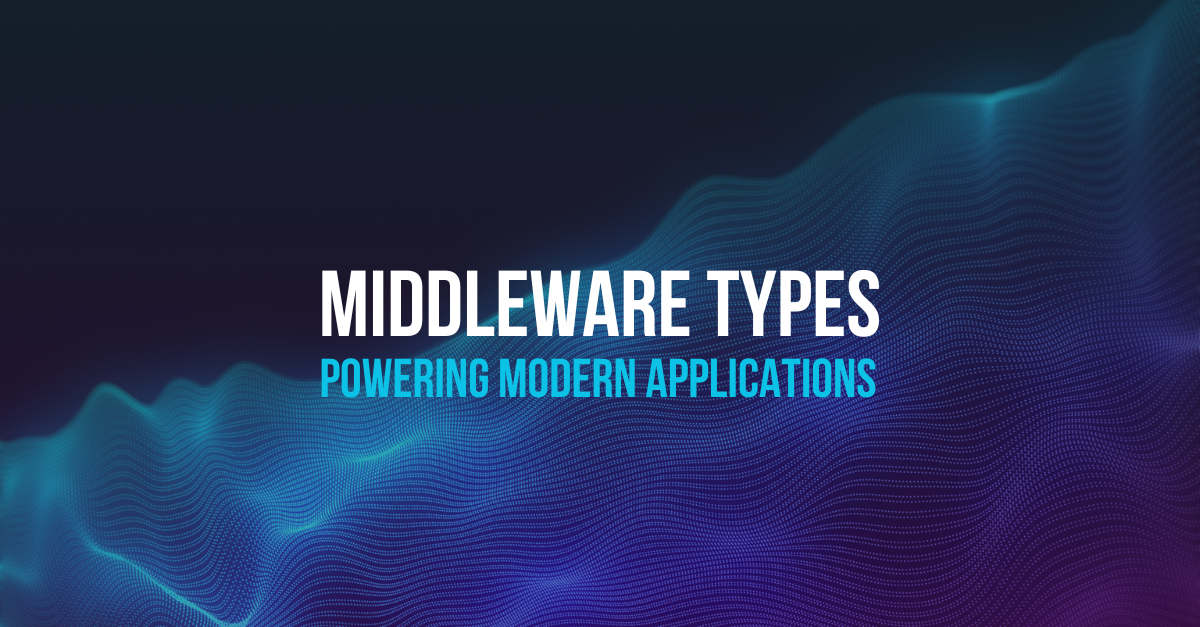Middleware types: Powering modern applications
Software powers the world, but middleware types keep it alive. These tools connect applications, data, and users with top efficiency. Modern tech leans on them completely. Without Middleware, systems crash under strain. This article unpacks middleware software types and their key roles. It defines them, lists benefits, and tracks trends ahead.
Table of Contents
Middleware types: What they are
Middleware types are software layers linking different systems. They sit between apps and operating systems or databases and move data and requests smoothly. Each type handles a unique connection task. Middleware categories in software architecture are split into groups.
Some focus on messages, others on transactions. Middleware glues tech pieces into working wholes. Developers count on it every day. Without it, apps can’t talk or function. Middleware quietly powers the digital world.
Middleware types: Core jobs
Middleware ties separate programs with no fuss. It shifts info across platforms fast. Builders use it to cut work time. Each type zeroes in on one role. Precision keeps everything humming along.
Middleware types: The main kinds
- Message-Oriented Middleware: This passes messages between app parts. It stacks data for steady handoffs. Systems lock step with no slips.
- Database Middleware: Database middleware joins apps to data stores. It speeds up access, cuts wait and climbs with it in place.
- Application Server Middleware: This type holds apps and runs them. It takes requests and fires back replies. Business tasks flow quickly and cleanly.
- Web Middleware: Web middleware runs online actions smoothly. It sorts website traffic and requests, and users hit pages thanks to it.
- Transaction Middleware: Transaction middleware guards’ data swaps tightly. It tracks payments and logs each step. Accuracy rules its every move.
Middleware types: Everyday impact
Middleware in cloud computing binds cloud tools to local kits, hooks on-site setups to far servers, and rolls data streams with no breaks. Middleware integration services mesh old tech with new, and firms keep workflows tight across all tools.
Banks lean on it for safe payments, retail tracks goods in real-time, and healthcare zips patient files around fast. Business Integration with Middleware unites teams with shared data, and output jumps when groups link up.
Middleware types: Big wins
Middleware cuts the app-building time down fast. It reuses code for quicker finishes, and costs shrink as work piles up. The middleware technologies overview shows the full lineup. Options slot into business needs perfectly.
How to scale business with adaptive Middleware shines here. Middleware takes bigger user hits. Traffic surges don’t faze it one bit. Systems stand tall under heavy loads. Middleware types deliver wins daily. Businesses thrive with their strength in play.
Middleware types: AI’s role
AI-driven automation in Middleware reshapes daily tasks. It sniffs out issues before they blow up, allowing jobs to fly with less human oversight. AI sifts data streams for gold, and middleware shifts to fit smart cues.
Automation kills errors and saves hours. Predictions dodge system wrecks ahead of time. Firms grab an edge with this pair. Middleware plus AI breaks new ground. Apps hit heights never seen before.
Middleware types: Tough spots
More ties mean bigger security holes. Middleware needs hard shields to hold up. Hackers aim at weak links first. Old gear bucks against new tech. Fixes need time and sharp skills.
Mismatched tools slow down some jobs. Teams fight daily with odd fits. Updates lag when needs race ahead. Middleware requires careful setup. Success hangs on plans and know-how.
Middleware types: Future glance
Middleware grows as tech leaps forward. The cloud boom stretches its grip wider. AI digs deeper into its core—speed locks in as the top need. Firms bet big on their strength.
New apps push Middleware harder daily. Cloud setups spike its use everywhere. Innovative gear begs for fast ties. Middleware holds the keys to what’s next, and its climb shows no end.
Middleware types: Smart picks
Match Middleware to what apps aim for. Size and goals steer the pick. Test each kind before going all in. Team skills set the rollout pace. The future wants to shape the best choice.
Types differ by task and weight. Some ace small jobs solo, while others juggle huge loads with ease. Good calls save cash and time, and Middleware paves the way for wins.
Middleware types fire up modern apps daily. They stitch systems into one tight unit, and firms run faster with them in play. Tech pushes on with Middleware’s might. Its strength only builds from here.
FAQs
Q1. What are the different types of middleware?
- Middleware types come in several flavors. Message-oriented Middleware handles data swaps between apps and queue messages for a steady flow.
- Database middleware links apps to storage systems. It speeds up data pulls and queries, improving performance.
- Application server middleware hosts and runs programs. It manages requests and replies quickly, and business tasks rely on it.
- Web middleware powers online interactions smoothly. It sorts HTTP traffic for websites. Users access pages with ease.
- Transaction middleware secures data exchanges tightly. It tracks payments and logs updates. Accuracy drives its every step.
Q2. What are the four functions of Middleware systems?
- Middleware systems connect apps to other tools. They bridge gaps between different platforms. Data moves without hiccups.
- They speed up processes across systems. Requests and replies zip through fast, and apps work quicker with less effort.
- Middleware hides complex coding from users. It simplifies building and running software, saving developers time on tough jobs.
- They boost reliability in operations daily. Systems stay steady under pressure. Crashes drop as Middleware holds strong.
Q3. What is an example of a Middleware?
- Apache Kafka stands out as Middleware. It moves data between apps in real-time, and messages flow fast and smoothly.
- Another case is the Oracle WebLogic Server. It hosts apps and handles runtime tasks, so business logic runs smoothly here.
- MySQL Connector links apps to databases. It pulls data quickly and cleanly. Queries finish in record time.
These show middleware types at work. They tie systems into one unit, and tech runs better because of them.
Q4. Is API a type of Middleware?
An API isn’t precisely Middleware. It sets rules for apps to talk, and communication happens through its structure. But APIs often pair with Middleware. Middleware types use APIs to link systems and collaborate on data flow. Think of APIs as a doorway. Middleware builds the house around them, making apps work. So, no, APIs don’t qualify alone. Middleware wraps them into bigger roles, and the combo powers modern tech.
Author








